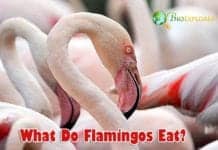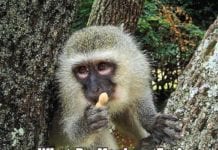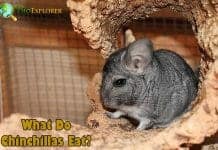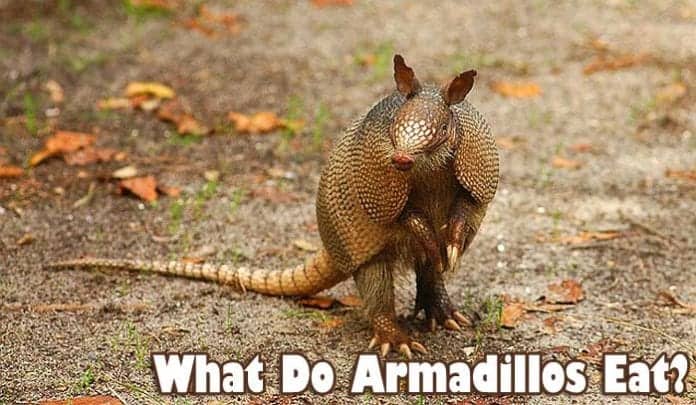
What Do Armadillos Eat? Armadillos are endemic to the Americas. Their shape resembles that of a barrel, and their bodies are covered with armor. Their natural armors come in handy to protect them from predators.
Armadillos are omnivores, feeding on a diet of both meat and plant materials. A good percentage of their diet (about 90%) constitutes larvae and insects.
Table of Contents
What Do Armadillos Eat?
| Southern Long-nosed Armadillo | Crickets, ants, termites, spiders, small vertebrate species, vegetation (fruits) and carrion. |
| Nine-banded Armadillo | Termites, arachnids, ants, earthworms, millipedes, grasshoppers, centipedes, small reptiles, bird eggs, small mammals, carrions, and plant matter. |
| Giant Armadillo | Termites, ants, worms, carrion, and small vertebrates. |
| Southern Three-banded Armadillo | Termites and ants |
| Pink Fairy Armadillo | Ants and other insects. |
Armadillos Diet By Types
Armadillos are classified in the family Dasypodidae, which is further divided into three subfamilies: Dasypodinae, Euphractinae, and Tolypeutinae.
About 21 extant species exist, and 2 extinct species have been noted in the family Dasypodidae.
Examples of the extant species will be studied in this section to understand the different types of armadillos and their habitats.
What Do Southern Long-nosed Armadillos Eat?
| Animalia | Cingulata | Dasypodidae | Dasypus | Dasypus hybridus |
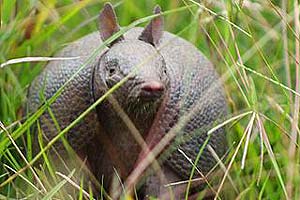 Southern long-nosed armadillo mainly eats invertebrates (crickets, ants, termites, and spiders), some small vertebrate species, vegetation (fruits) and carrion.
Southern long-nosed armadillo mainly eats invertebrates (crickets, ants, termites, and spiders), some small vertebrate species, vegetation (fruits) and carrion.
This armadillo is notable for its long snout. It inhabits grasslands, savannahs, and agricultural lands.
![]()
What Do Nine-banded Armadillos Eat?
| Animalia | Cingulata | Dasypodidae | Dasypus | Dasypus novemcinctus |
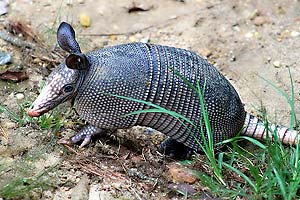 Nine-banded Armadillo is a generalist when considering its feeding habits. It feeds on termites, arachnids, ants, earthworms, millipedes, grasshoppers, and centipedes. They also eat small reptiles, bird eggs, small mammals, and plant matter (fruits, and seeds). They also eat carrions.
Nine-banded Armadillo is a generalist when considering its feeding habits. It feeds on termites, arachnids, ants, earthworms, millipedes, grasshoppers, and centipedes. They also eat small reptiles, bird eggs, small mammals, and plant matter (fruits, and seeds). They also eat carrions.
The bony shell of the nine-banded armadillo is divided into 9 bands. This armadillo inhabits grasslands, forests, and shrublands. It tends to have a preference for forests.
![]()
What Do Giant Armadillos Eat?
| Animalia | Cingulata | Dasypodidae | Priodontes | Priodontes maximus |
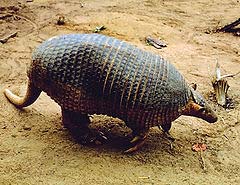 Giant Armadillo feeds on a specialized diet. This diet mainly constitutes of termites and some specific ant species. They have also been documented to feed on worms, carrion, and small vertebrates.
Giant Armadillo feeds on a specialized diet. This diet mainly constitutes of termites and some specific ant species. They have also been documented to feed on worms, carrion, and small vertebrates.
The giant armadillo can be differentiated from other armadillos thanks to its vast size. Its habitat regions include grasslands, rainforests (tropical and subtropical), woodlands, flood plains, and scrub forest.
![]()
What Do Southern Three-banded Armadillos Eat?
| Animalia | Cingulata | Dasypodidae | Tolypeutes | Tolypeutes matacus |
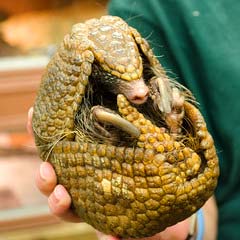 Southern Three-banded Armadillo mainly eats termites and ants.
Southern Three-banded Armadillo mainly eats termites and ants.
As the name suggests, the three-banded armadillo is known for its shell which has been divided into 3 bands.
These armadillo species inhabit the scrub forest or Savannah/grasslands.
![]()
What Do Pink Fairy Armadillos Eat?
| Animalia | Cingulata | Dasypodidae | Chlamyphorus | Chlamyphorus truncatus |
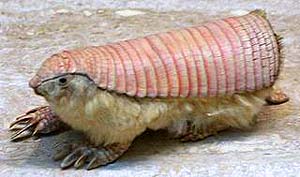 Pink Fairy Armadillo is mostly insectivorous feeding primarily on ants and other insects that they dig from the grounds they forage. It tends to feed on plant materials in certain circumstances.
Pink Fairy Armadillo is mostly insectivorous feeding primarily on ants and other insects that they dig from the grounds they forage. It tends to feed on plant materials in certain circumstances.
The pink fairy armadillo is the smallest species of the armadillos. The adults grow to a length of only 13 cm and weigh an average of 120 gm. They mostly inhabit grasslands and sandy plains. They can also be found in shrublands.
![]()
How Do Armadillos Hunt?
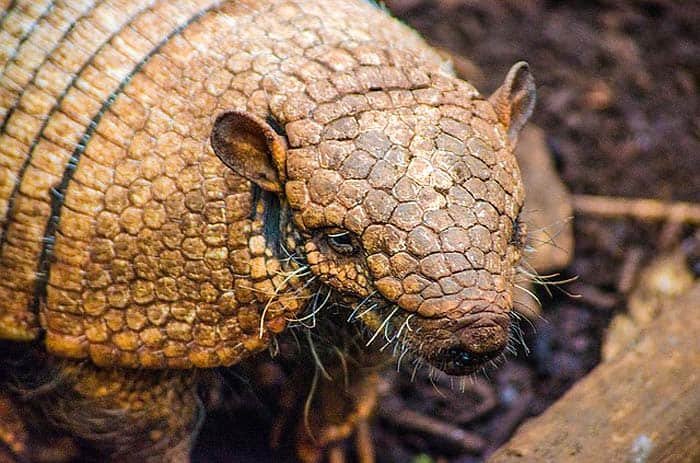
Hunting for the armadillos is a dynamic process that relies on their keen sense of smell.
- Their excellent sense of scent helps them find their prey. Armadillos also use their strong legs and big front claws to dig the ground to find and capture their prey which would otherwise be unavailable.
- Further, a sticky substance present in their mouths comes in handy to help them capture and immobilize their prey (insects).
![]()
When Do Armadillos Eat?
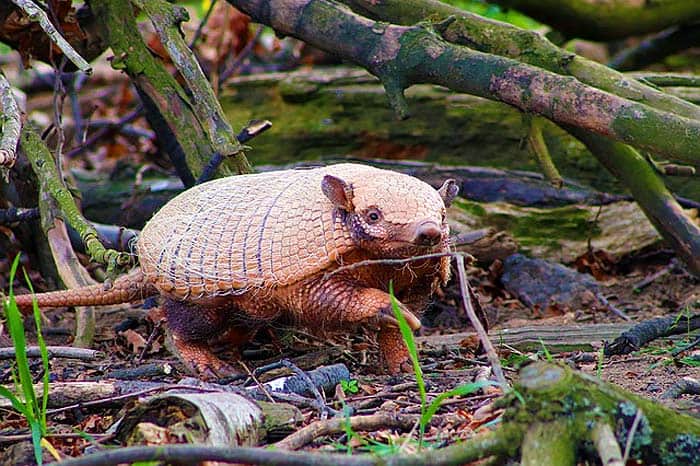
Most armadillo species are crepuscular, nocturnal or both.
- For instance, the nine-banded armadillo is nocturnal and crepuscular. This species can be seen being active on cloudy days.
- As temperatures become cool, the armadillos’ activity changes as they have been noted to become more diurnal.
- Other species like the six-banded armadillo is diurnal.
![]()
How Often Do Armadillos Eat?
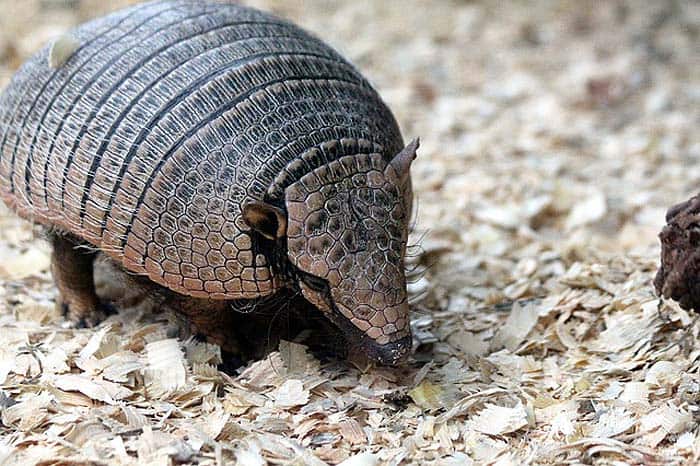
Armadillos sleep 16 hours every day.
- They spend the remaining hours foraging for food.
- Species like the nine-banded armadillo feed as often but will regularly pause to evaluate the findings of their desired food types like worms, beetles, insects, and grubs.
![]()
What Eats Armadillos?
![]()
Where Do Armadillos Fit in the Animal Food Chain?
Armadillos have an instrumental role to play in the animal food chain as both prey and predators.
- These animals are a source of food for organisms like snakes, humans, dogs, and jaguars.
- They, as a result, promote the survival of these animals. Armadillos feed on a wide array of invertebrates with the examples of insects, worms, and larvae.
- In so doing, armadillos keep the populations of these organisms under check.
![]()
Overall, the existence of armadillos confirms the presence of a healthy ecosystem.
![]()
Cite This Page
Key References
- “Armadillo Facts”. Accessed June 28, 2019. https://www.livescience.com/52390-armadillos.html.
- “ADW: Dasypus hybridus: INFORMATION”. Accessed June 28, 2019. https://animaldiversity.org/accounts/Dasypus_hybridus/.
- “ADW: Dasypus novemcinctus: INFORMATION”. Accessed June 28, 2019. https://animaldiversity.org/accounts/Dasypus_novemcinctus/.
- “ADW: Priodontes maximus: INFORMATION”. Accessed June 28, 2019. https://animaldiversity.org/accounts/Priodontes_maximus/.
- “ADW: Tolypeutes matacus: INFORMATION”. Accessed June 28, 2019. https://animaldiversity.org/accounts/Tolypeutes_matacus/.
- “ADW: Chlamyphorus truncatus: INFORMATION”. Accessed June 28, 2019. https://animaldiversity.org/accounts/Chlamyphorus_truncatus/.
- “Natural History Series: Nine-Banded Armadillo | UGA Cooperative Extension”. Accessed June 28, 2019. https://extension.uga.edu/publications/detail.html?number=C866-2&title=Natural%20History%20Series:%20Nine-Banded%20Armadillo.
- “Amazing Facts about the Armadillo | OneKindPlanet Animal Education”. Accessed June 28, 2019. https://onekindplanet.org/animal/armadillo/.
- “ADW: Dasypodidae: INFORMATION”. Accessed June 28, 2019. https://animaldiversity.org/accounts/Dasypodidae/.
- “File:Pink Fairy Armadillo (Chlamyphorus truncatus).jpg – Wikimedia Commons”. Accessed June 28, 2019. https://commons.wikimedia.org/wiki/File:Pink_Fairy_Armadillo_(Chlamyphorus_truncatus).jpg.
- “Tim Pierce | Flickr”. Accessed June 28, 2019. https://www.flickr.com/photos/qwrrty/.
- “Giant Armadillo | The giant armadillo is the largest member … | Flickr”. Accessed June 28, 2019. https://www.flickr.com/photos/42409752@N07/6264985347.
- “File:Southern long-nosed armadillo.jpg – Wikimedia Commons”. Accessed June 28, 2019. https://commons.wikimedia.org/wiki/File:Southern_long-nosed_armadillo.jpg.




